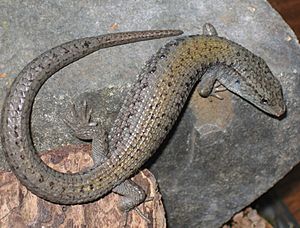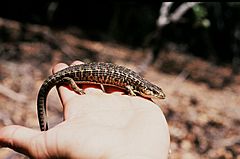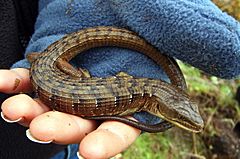Northern alligator lizard facts for kids
Quick facts for kids Northern alligator lizard |
|
|---|---|
 |
|
| Elgaria coerulea | |
| Scientific classification | |
| Genus: |
Elgaria
|
| Species: |
coerulea
|
| Synonyms | |
|
|
The northern alligator lizard (Elgaria coerulea) is a cool type of medium-sized lizard. It belongs to the family called Anguidae. This lizard is special because it lives only in the western parts of North America.
Contents
Understanding Lizard Names: Taxonomy
Scientists like to give animals special names to help them organize and study them. This system is called Taxonomy. The northern alligator lizard used to be known by the scientific name Gerrhonotus coeruleus. But now, scientists have moved it to a different group, or genus, called Elgaria.
Meet the Subspecies: Different Kinds of Northern Alligator Lizards
Just like there are different breeds of dogs, there are also different kinds of lizards within the same species. These are called subspecies. There are four main types of northern alligator lizards:
- E. c. coerulea – This one is known as the San Francisco alligator lizard.
- E. c. palmeri – This is the Sierra alligator lizard.
- E. c. principis – You might know this as the Northwestern alligator lizard.
- E. c. shastensis – This is the Shasta alligator lizard.
If you see a scientific name with three parts, like E. c. principis, it means it's a subspecies. The palmeri part of E. c. palmeri was named after an American zoologist named Theodore Sherman Palmer.
The E. c. principis subspecies is one of only five types of lizards that live in Canada.
What Does a Northern Alligator Lizard Look Like?
The northern alligator lizard is a slim, medium-sized lizard. When it's fully grown, its body (from its snout to where its tail starts) is about 10 cm (3.9 in) long. If you include its tail, it can be around 27.5 cm (10.8 in) long.
It has a special skin fold on each side of its body. This fold separates the rough, ridged scales on its back from the smooth scales on its belly. Its skin can be different colors, like brown and white or even greenish-yellow and brown. The back of the lizard is usually brownish. It often has dark spots that sometimes join together to form stripes. Young lizards might have a yellow throat and mouth area. Their bellies are light gray, and their eyes are dark.
What Do Northern Alligator Lizards Eat?
Northern alligator lizards are not picky eaters! Their usual meals include insects like crickets and beetles, as well as spiders and moths. But they are also brave enough to hunt bigger prey. They will even eat small lizards or tiny baby mice if they get the chance.
Life Cycle and Reproduction
Northern alligator lizards are special because they give birth to live young. This means they don't lay eggs like many other reptiles. A female lizard can have up to 15 babies, but usually, she has about 4 to 5. The babies are born between June and September.
During the spring, which is their breeding season, a male lizard will gently hold the female's head with his mouth. They can stay like this for many hours. This helps the male show the female how strong he is and that he would be a good partner.
Where Do Northern Alligator Lizards Live?
Ranges of
|
You can find the northern alligator lizard along the Pacific Coast and in the Rocky Mountains. They live from southern British Columbia in Canada, through Washington, northern Idaho, and western Montana. They also live south through Oregon to the coastal mountains and the Sierra Nevada in central California.
As the map shows, the different subspecies live in different areas. For example, E. c. principis is found in the most places. But E. c. coerulea mainly lives around the San Francisco area and also further north into Humboldt County.
These lizards are common along the Pacific coast. They can live from sea level all the way up to about 3,350 m (10,990 ft) high in the mountains. They like to live in many different kinds of forests and mountain areas with chaparral plants.
See also
 In Spanish: Lagarto aligator del norte para niños
In Spanish: Lagarto aligator del norte para niños





